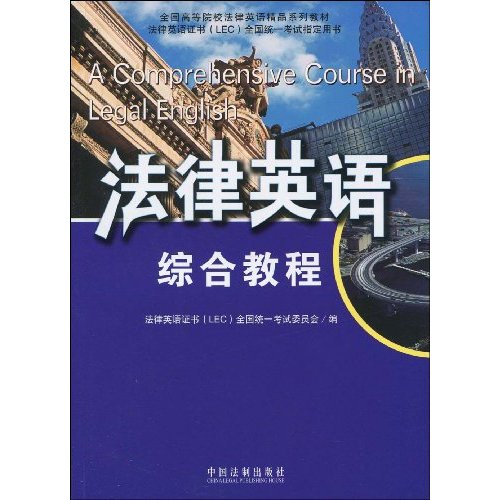
包邮法律英语综合教程

温馨提示:5折以下图书主要为出版社尾货,大部分为全新(有塑封/无塑封),个别图书品相8-9成新、切口有划线标记、光盘等附件不全详细品相说明>>
- ISBN:9787509314562
- 装帧:暂无
- 册数:暂无
- 重量:暂无
- 开本:03
- 页数:462
- 出版时间:2009-10-01
- 条形码:9787509314562 ; 978-7-5093-1456-2
本书特色
《法律英语综合教程》引用了许多极具代表性的英文案例。英美法系是判例法系,无论是法官还是律师都特别注重对判例的研究,因此学习美国法不能绕过案例,通过研究案例更有利于掌握标准的法律英语,也更容易掌握美国法的精髓。《法律英语综合教程》选取了十几个经典案例,以期*大程度的展现美国法原貌。随着我国入世和世界经济一体化进程的不断加快,国际交流合作日益增多,涉外法务活动空前频繁,法律英语的重要性日益凸显。掌握专业英语已经成为现代法律人**的职业素质。由于法律英语的特殊性,国内一直没有一个科学的考核指标衡量法律从业人员专业英语的掌握程度。法律英语证书(LEC)全国统一考试的推出为我国法律英语的教与学指明了方向,意义重大,影响深远。
内容简介
简介 随着我国入世和世界经济一体化进程的不断加快,国际交流合作日益增多,涉外法务活动空前频繁,法律英语的重要性日益凸显。掌握专业英语已经成为现代法律人**的职业素质。由于法律英语的特殊性,国内一直没有一个科学的考核指标衡量法律从业人员专业英语的掌握程度。法律英语证书(lec)全国统一考试的推出为我国法律英语的教与学指明了方向,意义重大,影响深远。
目录
节选
《法律英语综合教程》作为学习法律英语的精读教材,主要介绍美国法,希望读者通过学习权威、实用的美国法律知识,掌握地道、纯正的法律英语。一般的语言教材都会系统的讲授语法知识,但《法律英语综合教程》的编写设想学生已经完成了从中学英语到大学一、二年级的基础英语学习,系统掌握了英语语法等基础知识并有不低于六千英语词汇量。
相关资料
The field of torts embraces a group of civil wrongs'other than breach of contract'that inter-fore with person,property,reputation,or may sometimes be both a crime punishable by the statein a criminal prosecution and also a tort actionable by the victim in a suit for damages.Thecriminal prosecution and the damage action are quite separate and unrelated proceedings.Theessential purpose of the law of torts is compensatory and,though punitive damages may occa.sionally be awarded'its essentially punitive and an injured party is not awarded compensation inthe criminal proceeding.Tort law is chiefly state rather than federal law and so varies somewhat throughout thecountry.It may also be helpful to know something of the intellectual history of tort law in the UnitedStates.The following excerpt is only a small introduction to the fascinating subject:The emergence of Torts as an independent branch of tort law cflllle strikingly late in Ameri.can legal history.Although William Blackstone and his eighteenth-century contemporaries,intheir efforts to classify the law,identified a residual category of noncriminal wrongs not arisingout of contract,Torts was not considered a discrete branch of law until the late nineteenth cen.tury.The first American treatise on Torts appeared in 1 859;Torts was first taught as a separatelaw school subject in 1870;the first了orts casebook was published in 1874。 A standard explanation for the emergence of an independent identity for Torts late in the nineteenth century is the affinity of tort doctrines,especially negligence,to the problems produced by industrialization.The process by which Torts emerged as a discrete branch of law was more complex,however,and less dictated by the demands of industrial enterprise than the standard account suggests.Changes associated with industrial enterprise did provide many more cases involving strangers,a phenomenon that played a part in the emergence of Torts as all in.dependent branc
-

现代德治论-国家治理中的法治与德治关系
¥55.4¥64.0 -

名家散文精选系列 鲁迅散文精选青少版
¥18.1¥30.0 -

特效穴位拔罐图册
¥15.1¥29.0 -

中文版Photoshop CS5入门与提高-(配1张DVD)
¥34.6¥48.0 -

(双色)学霸课堂:幼小衔接·描红一本全-汉字
¥7.9¥16.8 -

六年级-门道-曹文轩讲作文-修订版-第五次印刷
¥9.5¥19.8 -

土木工程施工组织与概预算课程设计指南(土木工程专业课程设计指南系列丛书)
¥27.8¥37.0 -

宏观经济学:增长与分配
¥13.2¥38.0 -

国别与地区经济
¥19.3¥35.0 -

中华人物故事全书.美绘本:睿智先哲
¥17.2¥24.5
-

英文滑稽诗300首:英汉对照
¥12.3¥42.0 -

THE GREAT GATSBY-了不起的盖茨比
¥6.0¥16.8 -

小妇人(纯英文)/床头灯英语.3000词读物
¥6.4¥15.8 -

你往何处去
¥12.2¥33.0 -

MADAME BOVARY-包法利夫人
¥10.9¥36.8 -

英语六级词汇背诵精典 高教版
¥19.9¥89.8 -

名著名译英汉对照读本马克.吐温短篇小说选
¥10.5¥28.0 -

浮生六记(汉英对照)
¥18.6¥65.0 -

柳林风声
¥10.9¥29.0 -

夜莺与玫瑰-全2册
¥13.7¥29.8 -

英诗选译-孙大雨译文集-(英汉对照)
¥14.0¥36.0 -

许渊冲英译:毛泽东诗词·英汉对照(经典珍藏版)(精装)
¥53.8¥88.0 -

三曹诗选英译
¥14.3¥38.0 -

小王子-法文朗读原版
¥7.8¥20.0 -

牛津高阶英汉双解词典-第8版
¥104.7¥299.0 -

圣经故事
¥24.4¥49.8 -

每天读一点日文世界名人演讲精华集-日汉对译典藏版
¥15.0¥36.8 -

威克菲尔德的牧师-(英语原著版.第三辑)
¥5.2¥12.0 -

新概念英语一课一练 1
¥13.2¥19.0 -

儿童文学 美国K-12原版语文课本--初中·上(全12册)
¥86.4¥298.0













